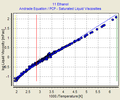Andrade equation
The Andrade equation is used to correlate the dynamic viscosities of pure substances . It is named after Edward Andrade , but CV Raman published this model in Nature in 1923 .
formulation
The equation describes a linear relationship between the logarithm of the viscosity and the reciprocal of the temperature :
With
- : dynamic viscosity
- : empirical constants
- : absolute temperature in K
- : Euler's number .
Goodness of fit
- Ethanol viscosity plots
The deviation plot shows that the Andrade equation does not adequately reproduce the course of the viscosity over the entire temperature range. It should therefore only be used in a very limited temperature range.
Example parameters
| b [K] | T (min.) [K] | T (max.) [K] | ||
|---|---|---|---|---|
| water | −6.944 | 2036.8 | 274 | 373 |
| benzene | −4.825 | 1289.2 | 273 | 483 |
| acetone | −4.003 | 842.5 | 183 | 329 |
| Ethanol | −5.878 | 1755.8 | 163 | 516 |
The table values each provide the dynamic viscosity η in m Pa * s.
See also
- DIPPR equations : DIPPR equations 100 and 101 are alternatives to the Andrade equation
- Dortmund database : database for experimentally determined viscosities
- Arrhenius equation








